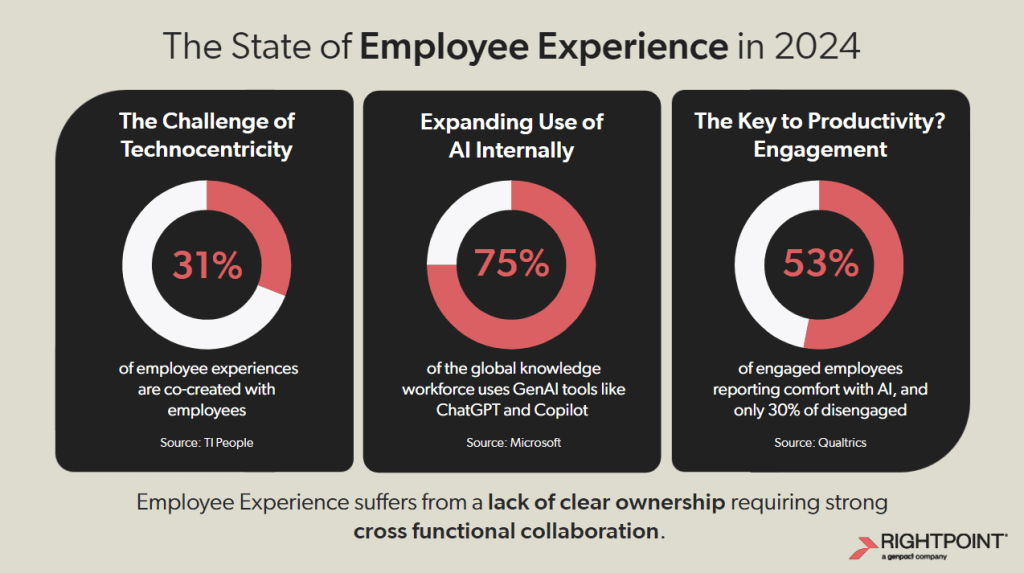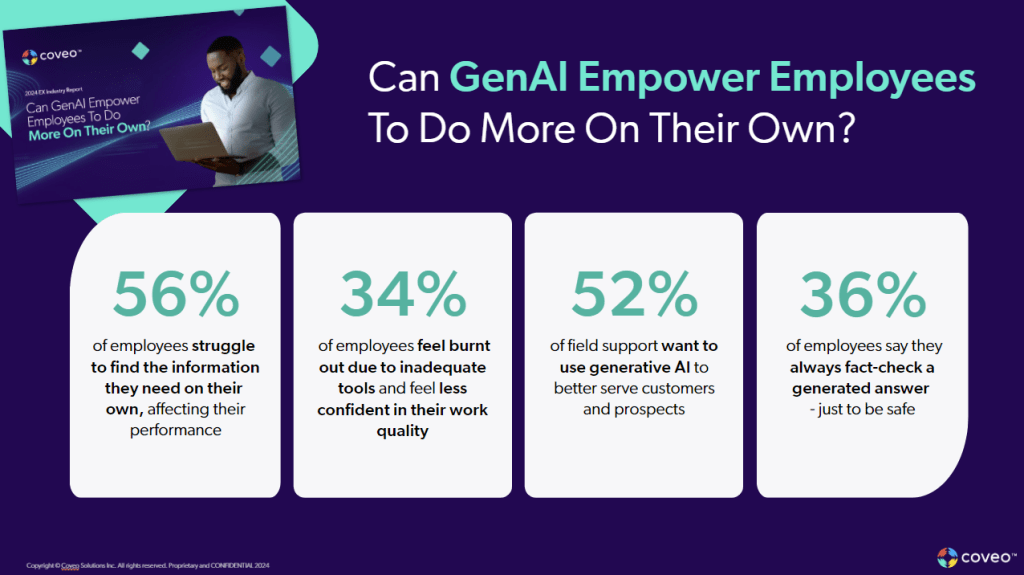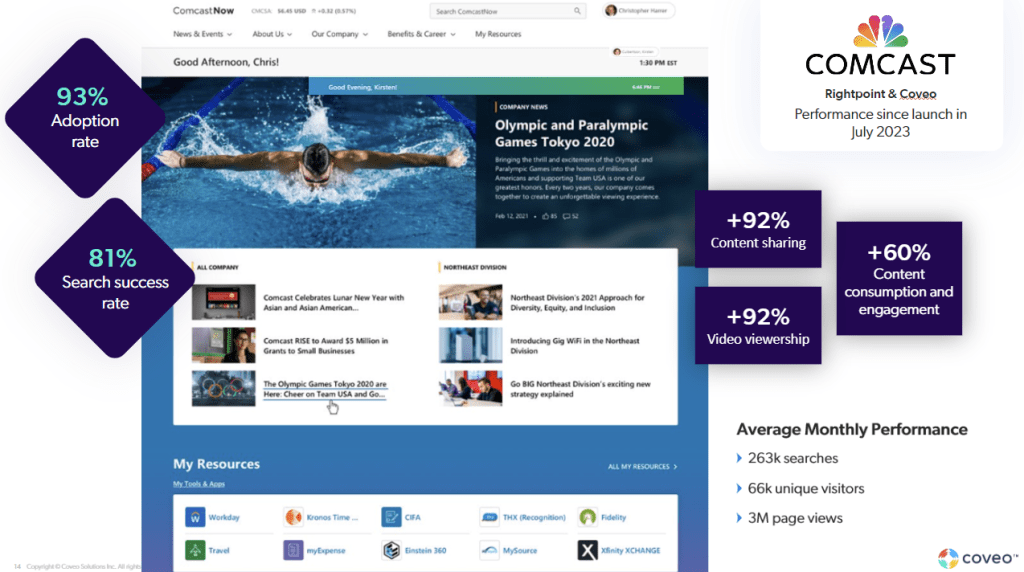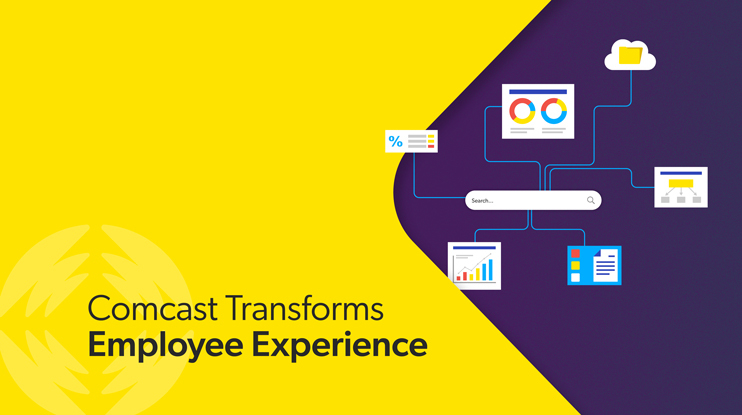AI’s impact on employee and workplace experience is impossible to ignore. The tech is changing how workers connect with information and each other. It’s fueling productivity, but also uncertainty, around how it can be used safely in an enterprise environment.
Comcast, a leading telecom and entertainment provider, has embraced the promise – and the challenges – of AI head on. The company transitioned away from their legacy intranet in 2020 under the guidance of Chris Harrer, Associate Vice President of Digital Internal Communications, and Kirsten Culbertson, Executive Director of Digital Technology Strategy. They partnered with Rightpoint and Coveo to implement an entirely new AI-driven approach to knowledge sharing and content management.
The journey hasn’t been without its challenges. Comcast needed to deploy AI in a way that made sense for an enterprise with more than 100,000 employees and contractors (safety and governance were key). They were also tasked with the enormous undertaking of backend reconfiguring to align tools in a way that made it easier to create, share, manage, and retrieve content.
Listen to the Full Conversation: Revolutionizing Employee Experience: The Power of AI and Unified Search
Inside this article:
- Employee Experience in 2024
- Additional EX Insights from Coveo
- Comcast’s EX Journey
- AI-Powered Search and Data Integration as the Path Forward
- What a workplace focused on employee experience looks like
- Comcast looks forward
Biggest Employee Challenge? Technocentricity
To better understand the significance of Comcast’s digital workplace journey and achievements, Rightpoint set the stage for the current state of employee experience.
Unfortunately, organizations are still approaching EX from a technology-first perspective. According to TI People, only 31% of new experiences are co-created with employees. This focus on technocentricity versus employee experience is what leads to adoption challenges.

“75% of knowledge workers use AI,” said Jesse Murray, Senior VP and Head of Employee Experience at Rightpoint. “Corporate-supported rollouts lag behind, indicating unmet employee demand.” Murray noted a strong link between engagement with new technologies and AI adoption. This suggests that when AI is implemented to improve experiences, employees are more likely to embrace new technologies.
The lack of clear EX ownership in many organizations points to a lack of cross-functional collaboration, particularly since employees are juggling more applications than ever. Pivoting to different applications in the flow of work is known as “context switching” and it’s a productivity killer.
Fueling this context switching is an often-frustrating search for information. According to Gartner, nearly half of digital workers struggle to find information needed to do their jobs. The number of applications desk workers use every day was about 11 in 2022, up from six in 2019.
Improving this fragmented experience is possible, but it requires an all-in approach to implementing and adopting new technologies and ways of working.
“Adoption isn’t a technology issue, it’s an employee experience issue,” Murray said about using new technology to improve EX. “Organizations that excel at employee experience have built relationships across the organization to generate the best outcomes.”
Relevant Reading: Coveo for Employee Experience Overview
Exploring How AI Can Improve Engagement
Following Murray’s insights, Patricia Petit Liang, Product Marketing Manager for Workplace at Coveo, shared the latest findings from the enterprise’s 2024 Employee Experience Industry Report. This report explores the impacts of AI search and generative AI technologies on both employee and customer expectations.
Petit Liang shared an exclusive preview of its findings to demonstrate the challenges leading employers continue to face, as 56% of the 4,000 U.S. and UK employees surveyed said they struggle to find the information they need to do their work.
Additionally:
- 34% of employees feel burned out due to inadequate tools
- 30% lack confidence in their work quality
- +50% of field support and sales staff want generative AI to improve customer service

Relevant Reading: Can Generative AI Empower Employees to Do More on Their Own?
Petit Liang emphasized, “At Coveo, we’ve been studying the effects of information flow on workplace productivity for several years. Issues like these persist mainly due to the exponential growth of data and the increasing number of tools employees use.
These insights really emphasize the importance of equipping your employees with the right tools to enhance their productivity and decision-making while reducing friction in their everyday interactions.”
How Comcast Transformed Their Employee Experience
Comcast’s journey to reimagine employee experience began with a complete redesign of their intranet. “We recently relaunched our intranet and we’ve been live since July 2023,” explained Culbertson. “It was a complete redesign, rethinking the entire experience for employees.”
The company faced several challenges that prompted this transformation. Their aging platform was inefficient, with communications staff spending over an hour just to build and publish a single page. Their previous solution had limited reach and personalization capabilities. It was also incredibly difficult for employees to find information because assets and files were scattered across multiple smaller intranets and SharePoint sites.
“We knew we had to move off of it,” Culbertson said. “We had to look to technology to fill some of those gaps. This was a critical time in our company.”
AI-Powered Search and Data Integration as the Path Forward
Comcast partnered with Rightpoint to implement Coveo’s AI-driven search technology as a future-proofing foundation. “We looked not only at the communication space, but also HR technology and the latest IT intake process,” Culbertson explained. “What can we do to streamline this experience and make it just easier for employees?”
They focused on several areas including:
- Implementing unified search across multiple data sources
- Leveraging AI-powered relevance and personalization
- Streamlining content management for communications teams
- Integrating HR systems and other critical platforms
This approach successfully reduced the number of clicks required for employees to complete tasks and made it easier to find the right information quickly. Culbertson used her own experience as an example. “With one click, I can now get to the point in Kronos where I need to ask for time off. Before the change, it took six clicks to get there.”
The new system uses Coveo’s AI search and personalized recommendations to provide in-the-moment advice if an employee is unsure how to complete a task. This helps employees focus on driving the company forward, instead of navigating complex systems and hunting for elusive information.
A Workplace Focused on Employee Experience
Comcast’s AI-powered employee experience initiative has been, by all measures, wildly successful. The new intranet launched with a monthly adoption rate of 93%, far exceeding industry standards.
Even more remarkable, the search success rate held steady at 80-81% after migration, despite the team’s initial concerns about potential drops in performance.

“We’re seeing significant improvements in how employees interact with content,” said Culbertson. Content sharing skyrocketed by 92%, while overall content consumption and engagement increasing 60%. Video viewership also saw a dramatic 92% boost, indicating that employees are finding and utilizing resources more effectively.
But perhaps the most striking outcome is the efficiency gained. “We saved employees 10 million clicks just from two integrations, based on an employee base of 80,000,” Culbertson shared.
The success of this initiative goes beyond numbers. It’s helped create a workplace where employees can easily access the information they need, when they need it.
As Culbertson put it, “If people are getting frustrated, they’re less productive. That’s just top of mind for me. If we can maintain the reputation of our intranet as a source of truth, that’s a win for everyone.”
Comcast’s Digital Workplace Vision
Looking ahead, Comcast sees its AI-driven approach as the start of a broader digital workplace transformation. Culbertson envisions leveraging generative AI to provide more conversational, context-aware answers to employee queries. We’re at the very early stages of envisioning what GenAI can do for companies and employee experience,” said Culbertson.
The industry leader is exploring ways to integrate these capabilities across multiple channels, including social media and messaging platforms popular in different regions. They want to create a truly connected, omnichannel support system that meets employees where they are.
Said Culbertson, “We’re continuously looking at how we can improve efficiency and get things done faster in a less frustrating way for employees. This is about how we pivot from a reactive environment to a much more proactive environment. We want to reach out proactively to give employees the guidance they might need, using AI and personalization.”
Learn more about how Coveo’s AI search and generative experience platform can help you achieve the workplace of the future today.
Dig Deeper
Implementing generative AI (GenAI) across your digital workplace? Discover use cases, best practices and KPIs to enhance the end-to-end employee experience!
Relevant Reading: Evaluating and Implementing Generative AI in the Workplace


